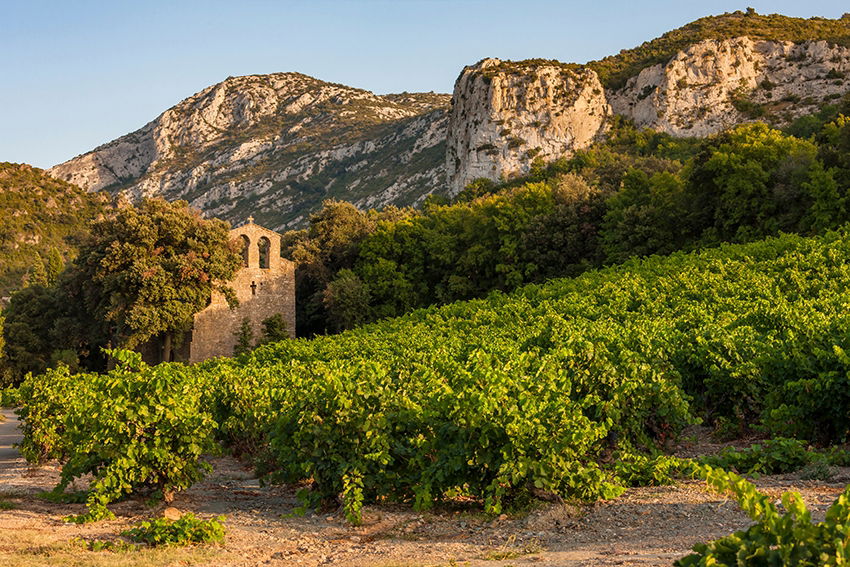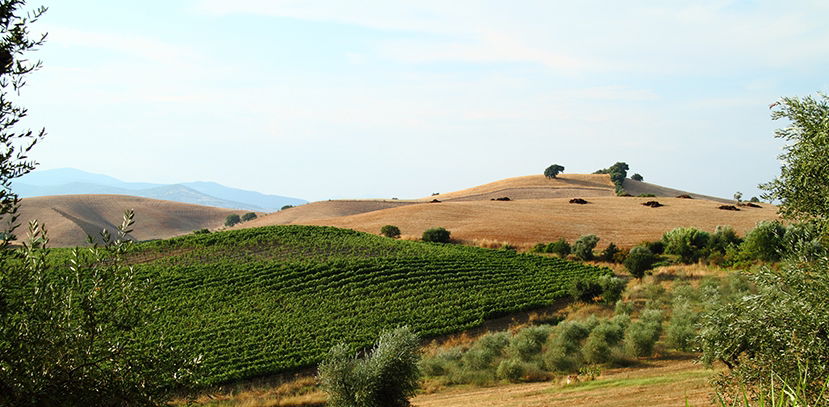BLOG
Top 5 AOCs to Discover in Languedoc and Roussillon
Andrew Jefford Regional Spotlight

For wine lovers, there are two Languedocs...
The easy one to visit is the coastal plain: that’s where most Languedoc-dwellers live, in busy, colorful cities like Montpellier, Beziers and Narbonne. It’s also where holidaymakers throng the safe, sandy beaches in summer. The wines grown down on the plain, though, tend to be inexpensive IGP picks – often great value, but rarely inspirational (though the fine Muscats are an exception, as is Picpoul de Pinet).
Then there are the hills: vast, wild, savagely beautiful, sparsely populated, where the great wines of Languedoc come into being. These dramatic, complex, characterful blends are crafted by winemakers living lives of struggle and endurance (a huge contrast to the lavishly remunerated wine farmers lucky enough to work in the most-visited parts of Bordeaux and Burgundy). If you don’t know Languedoc, you don’t yet know France – or French wine.

Don’t forget Roussillon either. It’s often linked with Languedoc, yet its wholly different not just in cultural terms (this is French Catalonia, famous as the last redoubt of the Cathar heretics) but as a biotope, too. Like Languedoc, Roussillon has two faces, though in this case two of equal grandeur. Its great table wines are fashioned inland, notably in the roomy Agly valley; while a long and treasured tradition of fortified-wine making persists along the rocky, schist-soiled coastline – though dry, unfortified wines are increasingly common along this ‘Vermilion Coast’ as well.
Here are five appellations to remember as you explore the region.
Pic St Loup
Is this Languedoc’s luckiest appellation? Its immaculately weathered limestone soils insist on a wine-growing vocation; its climate is a little wetter and cooler than those of appellations further south and west, meaning that this is perhaps the greatest spot in Languedoc for Syrah; and it lies within easy reach of Languedoc’s busy, populous capital, Montpellier. Topographically, too, you just know that this is great wine country, clinging to the the prow-like Pic itself, the cliffs of Hortus and the long escarpment that stretches back to the north. No surprise, then, that the appellation bulges with winemaking talent.
Names to watch:
- Bergerie du Capucin
- Mas Brugière
- Château de Cazeneuve
- la Chouette du Chai
- Domaine Clavel
- Domaine Haut-Lirou
- Domaine de l’Hortus
- Château de Lancyre
- Domaine Mirabel
- Mas Mortiès
- Domaine Pégaline

Terrasses du Larzac
This huge appellation stretches from remote Moulès et Baucels and the vineyards of the ‘lost valley’ of the Buège (complete with its immaculate spring) down to the heartland of Montpeyroux, Jonquières and busy St André de Sangonis underneath lofty Mont St Baudille. It then turns north again and romps back up into the hills via the extraordinary schist rockyards of St Jean de la Blaquière to lofty Pégairolles de l’Escalette, a true mountain vineyard zone. There’s prodigious potential here, and the best wines of the Terrasses du Larzac have a nerve, a vitality and an inner complexity you don’t readily find elsewhere, though they tend to be less fleshy and flamboyant than their peers. Remember, too, that this is where you find long-term Languedoc pioneer Mas de Daumas Gassac, though it uses IGP rather than AOC for its elegant Cabernet-based red.
Names to watch:
- Château Capion
- Mas Cal Demoura
- Mas Combarèla
- Domaine de Ferrussac
- Mas Jullien, Mas Lasta
- Pas de l’Escalette
- La Pèira
- Mas de Quernes
- Clos du Serres
- Domaine Terre de Feu
- Les Vignes Oubliées
St Chinian
Every wine student knows St Chinian – since it’s one of the few appellations in France whose wines are produced on two clearly contrasting soil types, schist and limestone. Nuancing the two sectors in scent and flavour is a fascinating challenge. What I love about the appellation, though, is that this set of wines (from yet another iteration of beautiful, remote, garrigue-covered hills) seems to combine the richness and juiciness of flesh typical of the Western Languedoc with the structure, inflection and nuance you tend to find further East. St Chinian is the happy medium, the middle way – and outstanding quality and ageing potential is possible here, too.
Names to watch:
- Vignoble Belot
- Borie la Vitarèle
- Clos Bagatelle
- Château Castigno
- Château de Ciffre
- Château Coujan
- Mas Champart
- Mas de Cynanque
- Château la Dournie
- Château Fonsalade
- Domaine la Linquière
- Château Milhau-Lacugue
- Laurent Miquel
- Domaine Les Païssels
- Domaine de Pradels-Quatironi
- Château du Prieuré des Mourgues
- Cave de Roquebrun
- Domaine de Viranel

Faugères
Faugères takes the schist theme from its neighbour St Chinian – and makes it the whole story. All of the vineyards of Faugères are rooted in schist which, to the casual glance, almost resembles the Douro valley or Priorat in its rocky outcrops and their lack of soil. That extra touch of mineral austerity, combined with slightly higher vineyard altitudes than many parts of St Chinian, lead the wines of Faugères away from voluptuous fruit and towards something more sinewy, stony and haunting than those of St Chinian, though extravagant ripeness is always possible here. Look out, too, for the rosé wines of Faugères: bright, firm and stony once again, full of metaphorical glints and shards.
Names to watch:
- Abbaye Silva Plana
- Mas d’Alezon
- Bardi d’Alquier
- Léon Barral
- Domaine de Cébène
- Château Chenaie
- Château des Estanilles
- Mas Gabinèle
- Château de la Liquière
- Mas Lou
- Domaine la Tour Penedesses

Maury and the Agly Valley
There are few more evocative views in the South of France than the view from the vineyards of Mas Amiel, looking up to the ruined Cathar fortress of Queribus. Climb up to that fortress, moreover, and you can follow the Agly Valley far up to the wild Fenouillèdes: vineyard after vineyard, coaxed from soils and stones which change ceaselessly, here, in a swirling matrix. Summers are hot and dry and ripeness comes easily – but that still doesn’t quite explain the power and the density of the best of the wines grown here, allied to an exotic, almost incense-like richness you won’t find in Languedoc (even just over the ridge line in Corbières). The Maury Sec appellation marks out the heart of the valley, but there are many fine Agly wines which go to market under the Côtes du Roussillon-Villages appellation, too, including its crus Latour-de-France, Lesquerde, Caramany and Tautavel.
Names to watch:
- Mas Amiel
- Domaine Danjou-Banessy
- Domaine Gardiés
- Mas Mudigliza
- Clos del Rey
- Domaine des Schistes
- Domaine des Soulanes




